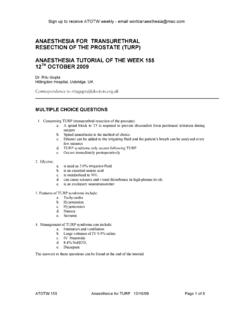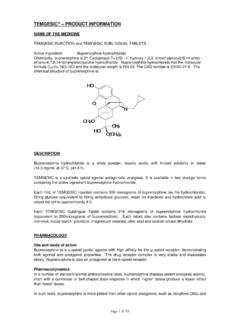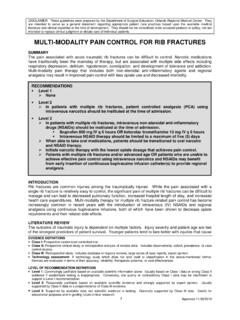Transcription of NEW ZEALAND DATA SHEET - Medsafe
1 NEW ZEALAND data SHEET OxyNorm Capsules & Oral Liquid (OXYNORM011) 29 June 2017 Page 1 of 14 OXYNORM Capsules OXYNORM Oral Solution Oxycodone hydrochloride 1 PRODUCT NAME OXYNORM 5mg Capsules OXYNORM 10mg Capsules OXYNORM 20mg Capsules OXYNORM 5mg/5mL Oral Solution 2 QUALITATIVE AND QUANTITATIVE COMPOSITION OXYNORM capsules contain Oxycodone hydrochloride 5 mg, 10 mg or 20 mg. OXYNORM oral solution contains Oxycodone hydrochloride 5 mg/5 mL For the full list of excipients, see section 3 PHARMACEUTICAL FORM OXYNORM capsules 5 mg (orange/beige) OXYNORM capsules 10mg (white/beige) OXYNORM capsules 20 mg (pink/beige) OXYNORM liquid 5 mg/5 mL is a clear, colourless to straw-coloured solution 4 CLINICAL PARTICULARS Therapeutic indications The management of opioid-responsive moderate to severe pain.
2 Dose and method of administration Adults, elderly and children over 18 Years Prior to initiation and titration of doses, refer to the Section information on special risk groups such as females and the elderly. OXYNORM capsules or liquid should be taken at 4-6 hourly intervals. The dosage is dependent on the severity of the pain, and the patient s previous history of analgesic requirements. Increasing severity of pain will require an increased dosage of OXYNORM capsules or liquid. The correct dosage for any individual patient is that which controls the pain and is well tolerated throughout the dosing period. Patients should be titrated to pain relief unless unmanageable adverse drug reactions prevent this.
3 OXYNORM capsules or liquid will generally be used in a short term trial (4-6 weeks) to determine if the pain is opioid responsive, before transferring to a longer acting oxycodone preparation such as OXYCONTIN tablets, in accordance with the clinical guidelines on the use of opioid analgesics in such patients ( those published by the Australian Pain Society in the Medical Journal of Australia NEW ZEALAND data SHEET OxyNorm Capsules & Oral Liquid (OXYNORM011) 29 June 2017 Page 2 of 14 1997; 167: 30-4). However, OXYNORM liquid may be used longer term in patients unable to take solid oral dosage forms, or when more precise dose titration is necessary. The usual starting dose for opioid-na ve patients or patients presenting with severe pain uncontrolled by weaker opioids is 5mg, 4-6 hourly.
4 The dose should then be carefully titrated, as frequently as once a day if necessary, to achieve pain relief. The majority of patients will not require a daily dose greater than 400 mg. However, a few patients may require higher doses. Patients receiving oral morphine before oxycodone therapy should have their daily dose based on the following ratio: 10 mg of oral oxycodone is equivalent to 20 mg of oral morphine. It must be emphasized that this is a guide to the dose of OXYNORM capsules or liquid required only. Inter-patient variability requires that each patient be carefully titrated to the appropriate dose. Controlled pharmacokinetic studies in elderly patients (aged over 65 years) have shown that compared with younger adults, the clearance of oxycodone is only slightly reduced.
5 No untoward adverse drug reactions were seen based on age, therefore, adult doses and dosage intervals are appropriate. Adults with mild to moderate renal impairment and mild hepatic impairment The plasma concentration in this patient population may be increased. Therefore, dose initiation should follow a conservative approach (refer Section ). Children under 18 years OXYNORM capsules or liquid should not be used in patients under 18 years. Multiplication Factors for Converting the Daily Dose of Prior Opioids to the Daily Dose of Oral Oxycodone* (mg/day prior opioid x Factor = mg/day oral oxycodone) Oral Prior Opioid Parenteral Opioid Oxycodone 1 - Codeine - Hydromorphone 4 20 Pethidine (Meperidine) Methadone 3 Morphine 3 * To be used for conversion to oral oxycodone.
6 For patients receiving high-dose parenteral opioids, a more conservative conversion is warranted. For example, for high-dose parenteral morphine, use instead of 3 as a multiplication factor. NEW ZEALAND data SHEET OxyNorm Capsules & Oral Liquid (OXYNORM011) 29 June 2017 Page 3 of 14 Method of administration OXYNORM capsules should be swallowed whole and not opened, chewed or crushed. Limited data suggest that food may significantly increase the amount of oxycodone absorbed from an oral solution see Absorption under Pharmacokinetics. Alcoholic beverages should be avoided while the patient is being treated with OXYNORM capsules or liquid. Non-malignant pain In common with other strong opioids, the need for continued treatment should be assessed at regular intervals.
7 Contraindications Hypersensitivity to opioids or to any of the constituents of OXYNORM capsules or liquid, acute respiratory depression, cor pulmonale, cardiac arrhythmias, acute asthma or other obstructive airways disease, paralytic ileus, suspected surgical abdomen, severe renal impairment (creatinine clearance < 10mL/min refer to Section ), severe hepatic impairment, delayed gastric emptying, acute alcoholism, brain tumour, increased cerebrospinal or intracranial pressure, head injury (due to risk of raised intracranial pressure), severe CNS depression, convulsive disorders, delirium tremens, hypercarbia, concurrent administration of monoamine oxidase inhibitors or within two weeks of discontinuation of their use.
8 Pregnancy. Not recommended for pre-operative use. Special warnings and precautions for use Respiratory depression and sedation The major risk of opioid excess is respiratory depression including subclinical respiratory depression. Profound sedation, respiratory depression, coma, and death may result from the concomitant use of OXYNORM with benzodiazepines or other CNS depressants ( , non-benzodiazepine sedatives/hypnotics, anxiolytics, tranquilizers, muscle relaxants, general anaesthetics, medicines with antihistamine-sedating actions such as antipsychotics, other opioids, alcohol). Because of these risks, reserve concomitant prescribing of these drugs for use in patients for whom alternative treatment options are inadequate.
9 Observational studies have demonstrated that concomitant use of opioid analgesics and benzodiazepines increases the risk of medicine-related mortality compared to use of opioid analgesics alone. Because of similar pharmacological properties, it is reasonable to expect similar risk with the concomitant use of other CNS depressant drugs with opioid analgesics (see Section Interactions with other medicines and other forms of interaction). If the decision is made to prescribe a benzodiazepine or other CNS depressant concomitantly with an opioid analgesic, prescribe the lowest effective dosages and minimum durations of concomitant use. In patients already receiving an opioid analgesic, prescribe a lower initial dose of the benzodiazepine or other CNS depressant than indicated in the absence of an opioid, and titrate based on clinical response.
10 If an opioid analgesic is initiated in a patient already taking a benzodiazepine or other CNS NEW ZEALAND data SHEET OxyNorm Capsules & Oral Liquid (OXYNORM011) 29 June 2017 Page 4 of 14 depressant, prescribe a lower initial dose of the opioid analgesic, and titrate based on clinical response. Follow patients closely for signs and symptoms of respiratory depression and sedation. Advise both patients and caregivers about the risks of respiratory depression and sedation when OXYNORM is used with benzodiazepines or other CNS depressants (including alcohol and illicit drugs). Advise patients not to drive or operate heavy machinery until the effects of concomitant use of the benzodiazepine or other CNS depressant have been determined. Screen patients for risk of substance use disorders, including opioid abuse and misuse, and warn them of the risk for overdose and death associated with the use of additional CNS depressants including alcohol and illicit drugs (see Section Interactions with other medicines and other forms of interaction).















